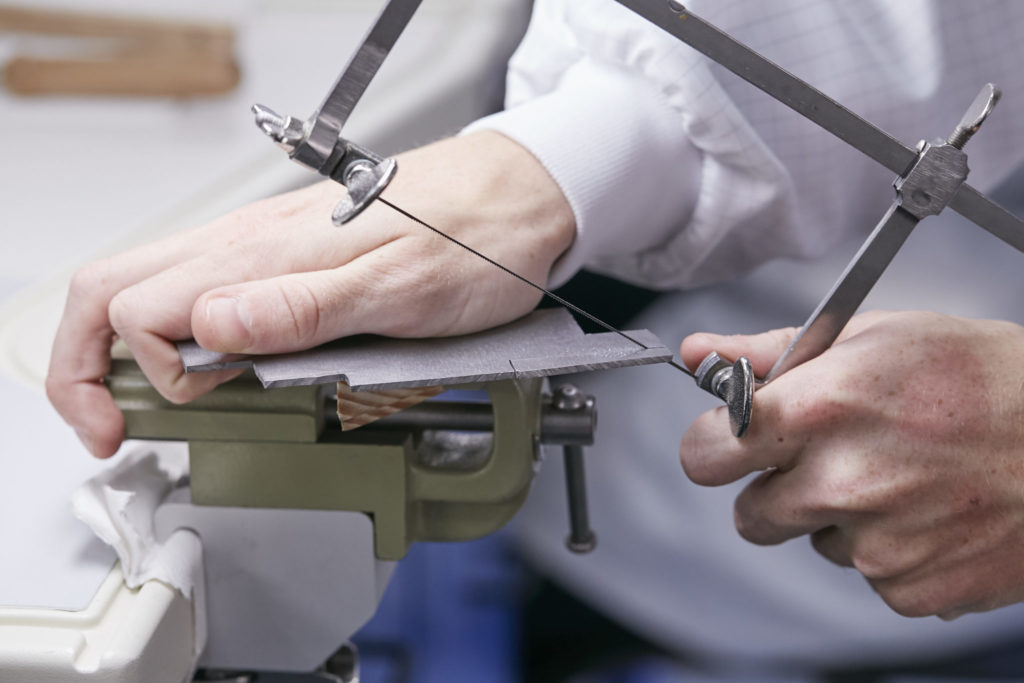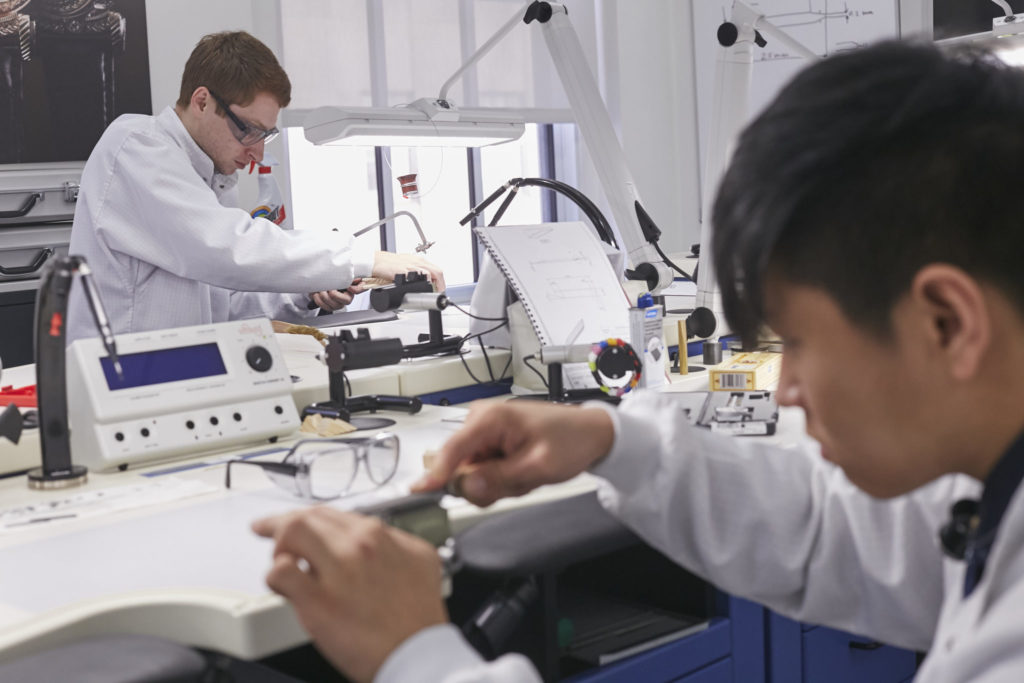Since 1839, Patek Philippe has produced the world’s most coveted, complicated timepieces. Today, the company is cultivating the next generation of elite watchmakers.
By Ashley Muldoon Lavin
“For me, it’s what I want to do as my life’s purpose.”
In a pristine, glass-encased classroom overlooking St. Patrick’s Cathedral in New York City, six young men labor in near silence. Cloaked in identical white lab coats, with their heads bent over their workbenches, they could be mistaken for devotees to some sort of monastic order. But it’s not bibles they are consulting—it’s schematics. And these men aren’t monks. They are student watchmakers and they are praying at the altar of Patek Philippe.
Founded by the Swiss-based luxury watch company in 2015, the Patek Philippe Institute of New York was created to respond to a looming, Catholicism kind of crisis: attrition.
“We’d been looking for ways for decades to try to find watchmakers,” says Larry Pettinelli, President of Patek Philippe U.S. “We were able to maybe find one person a year. And with our people retiring—sometimes two in a single year—we were never making up any ground.”
The exodus of skilled craftspeople from the workforce affects most luxury brands these days, but Patek has reason to feel especially pained. The last remaining family-owned watch manufacture in Geneva, the company has been operating continuously for nearly 180 years. That long history has allowed Patek to not only perfect its craft—its cases are famously made mostly in-house and are often hand-forged from single pieces of gold or platinum using techniques that date back to the company’s 1839 founding—but also to experiment with it. Patek’s archives feature an array of styles, designs, and complications that other brands, who might focus on a singular look or model, can’t claim to offer.
Collectors, attracted by the unique, limited-edition feel of the company’s releases, line up to plunk down over six figures for new Pateks. And vintage designs—like the rare 1941 steel perpetual calendar chronograph that sold for $11 million last year—continually shatter records at auction.
 The result? Patek’s New York City repair shop is scheduled to see more than 10,000 watches in 2017 alone. So it’s not just that good watchmakers are hard to find; it’s that Patek does not have the time to even begin searching for them. To save itself from disaster (not to mention the headaches that come with telling a customer that there is a months-long service delay on his $100,000 timepiece) Patek realized that if it wanted more and better watchmakers, it would have to build them itself—from scratch.
The result? Patek’s New York City repair shop is scheduled to see more than 10,000 watches in 2017 alone. So it’s not just that good watchmakers are hard to find; it’s that Patek does not have the time to even begin searching for them. To save itself from disaster (not to mention the headaches that come with telling a customer that there is a months-long service delay on his $100,000 timepiece) Patek realized that if it wanted more and better watchmakers, it would have to build them itself—from scratch.
The company broadened its operation in Geneva, opened a school in Shanghai, and then—when a move to their Rockefeller Center offices afforded them the space to include a classroom at the back of their new, expanded workshop—unveiled the Patek Philippe Institute of New York. Then it made two very smart decisions: veteran watchmaker Laurent Junod would serve as the Institute’s director of technical training (“It’s like learning from Carlos Santana how to play guitar,” boasts Pettinelli) and tuition would be free, with no obligation to work for Patek upon graduation.
“That was important,” says Pettinelli. “We wanted to bring in local kids who maybe hadn’t found their path yet and give them some direction.”
It’s a laudable idea—and one that’s paid off spectacularly. The Institute received over 400 applications in its first year and graduated five watchmakers this fall—all of whom accepted positions in Patek’s New York City repair shop upon passing their Level 2 Certification in Geneva. They now perform interventions on mechanical and quartz Pateks on a bench just outside the classroom where they once studied.
The Institute’s second batch of recruits—six young men chosen from 450 applicants this time—sit in that room now. One gave up a lucrative career in banking to attend; one still works nights and weekends as a restaurant manager in order to make ends meet while he is at the school. Another recounts how, at the age of 12, he saw the inside of a pocket watch and had what felt like a religious experience. (He abandoned an engineering program to come to the Institute).
And though they had to endure a months-long interview process and a final, frustrating day of math, logic, and dexterity testing in order to get there, each talks about his new calling with the passion of the freshly converted. “For me, it’s what I want to do as my life’s purpose,” says one. Says another: “Just being able to step into the building is … wow.” One more marvels: “I still have those moments where I can’t believe that this is actually real.” (Patek asked Watch Journal to omit the students’ names. Like the church, it eschews individualism.)
“They came here with complete enthusiasm,” boasts the aforementioned Junod in his endlessly charming Swiss accent.
And that’s a good thing, considering the two-year-long concentrated course of study that awaits them. Monday through Friday these students will work from 9 a.m. to 5 p.m. to master not only the WOSTEP technical skills they would learn at other horology schools, but also the time-honored techniques that Patek watchmakers have passed down for generations. They begin by handmaking the tools they will use for the rest of their careers. It’s a process that takes nine months, and its purpose is to teach them the sensitivity and dexterity required to effectively wield such implements at a micro level. After that, they turn to watches—but not Pateks. They start by taking apart a large pocket watch about 25 times until they understand the theory behind how it works and how to maintain it.
“They will know this movement by heart,” says Junod. “So once they know how this watch works, then we can go to a smaller one. And then a smaller one. And then one with a little complication—a calendar. And then an automatic. And then a ladies’.”
The process goes on and on, getting smaller and more complicated, until, upon their one-year anniversary at the Institute, the students are finally allowed to touch a Patek. They spend the next year memorizing the workings of the company’s quartz and mechanical models until they are finally flown to Geneva to visit Patek’s factories—and to take their Level 2 exam.
Even when Junod discusses the test—which involves a Patek Philippe watch that has been tricked out with five to seven defects that the students will have to discover and repair before recasing the whole thing—the students never seem less than thrilled. And, later, when Junod talks about his charges, it becomes clear that the feeling is entirely mutual. “Those are great people,” he says. “I really love them.”
Junod is a natural teacher—even he agrees, at one point remarking with delightful Swiss candor: “It fits me perfectly well, yes?” He’s also a great evangelist for what the brand hopes to accomplish with the Institute.
“There is a lot of lost talent everywhere,” says Junod, remarking on what a shame it would be if his hyper-enthusiastic students were still just passing time in jobs they didn’t love. “If all industries could just pick up those people—because they do exist! They do exist and they have a lot to give!”
COURSE OF STUDY
Watchmakers operate at various levels according to their skill. For Patek’s best and brightest, graduating from the Institute is only the beginning…
LEVEL 2
After passing their Level 2 exam in Geneva, the Institute’s graduates are ready to perform interventions involving quartz movements and manually wound or self-winding mechanical movements, such as those found on the Patek Philippe Ref. 5116R Men’s Calatrava.
LEVEL 3
A Level 2 watchmaker must practice for three more years before he can return to Geneva for a Level 3 course and test—though Pettinelli is quick to point out that many never advance to this stage. Those that do will be qualified to service watches like the Patek Philippe Ref. 7130G Ladies World Time, with more complicated movements.
LEVEL ADVANCED
If a watchmaker is truly skilled, and has operated at Level 3 for three or more years, he can attempt to earn a Level Advanced certification at the Geneva headquarters. There, he’ll learn how to manipulate grand complications like those found on the Patek Philippe Ref. 5140P Men’s Perpetual Calendar and how to hand-finish some parts.


